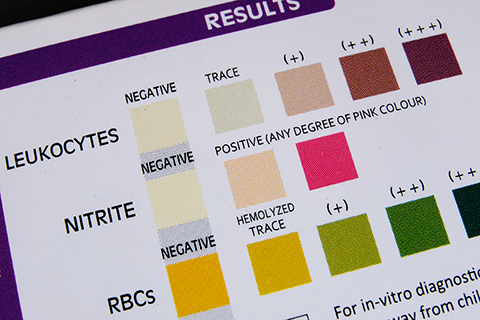How do doctors diagnose urinary tract infection?
Diagnosis for a urinary infection is usually done in the GP surgery or a walk-in clinic. After you explain your symptoms, a mid-stream urine sample is taken and a dipstick test is carried out to check for:
- White blood cells – Also known as leucocytes, the presence of white blood cells This indicates that there is inflammation or infection in the urinary tract or kidneys and the body is excreting more white blood cells to destroy any possible bacterial infection
- Red blood cells – The bladder can bleed due to severe inflammation and the constant urination caused by a UTI. Some people can feel a “razor blade sensation” when urinating during a UTI attack
- Protein – The presence of protein can indicate a possible kidney infection as only trace amounts normally filter through the kidneys
- Nitrates – Gram-negative bacteria like e-coli, which can cause a UTI, make an enzyme that changes waste urinary nitrates to nitrites
Any sign of these in the urine indicates bladder inflammation and a probable infection as the body’s immune system is reacting to the infection but could also indicate other conditions.
Depending on the dipstick analysis, the GP may send the sample to a laboratory where they culture the urine for bacterial growth. The GP will discuss your symptoms with you, taking into account other current or previous health issues and any family disease history.
There are three different types of UTI:
- An acute UTI – an uncomplicated infection which causes very painful, unpleasant symptoms which usually clear up quickly with a short course of antibiotics.
- A recurrent UTI – an infection with a frequency of 2 or more infections in 6 months or 3 or more in the past 12 months, although frequency can be more. The infection usually responds to antibiotics each time and usually gives no symptoms between attacks.
- A long-term, chronic UTI – this is where symptoms of infection are ongoing, but they can wax and wane in severity. A chronic UTI often starts with an acute infection that doesn’t get better or seems to clear up while on antibiotics, but then comes back and persists. These infections aren’t cleared by short courses of antibiotics as short courses aren’t long enough to clear symptoms. Chronic infections may not be picked up on a dipstick and/or standard MSU culture. They are hard to treat and as yet, there are no treatment guidelines for doctors to follow.

Negative test results –
Why tests can show negative despite an infection being present
Unfortunately, both dipstick test and the mid-stream urine culture test aren’t reliable and miss infections. There are several reasons for this:
Diagnostic criteria for UTI are based on outdated research
The use of MSUs and dipstick tests to diagnose UTIs are based on research by a scientist called Kass from the 1950s based on a study of a small number of pregnant women suffering from severe infections of the kidneys. These women, who were not suffering from lower urinary tract infections, are not representative of the typical UTI sufferer.
- The current microbiological criteria to diagnose UTI, called the Kass Criteria, is set very high, meaning that levels of infection under this threshold are discounted. The Kass criteria threshold looks for at least 105 (100,000) bacteria per millilitre of urine of a single species of a known pathogen. But UTI symptoms can be caused by low levels of pathogens and caused by more than one pathogen
- The Kass criteria assumes that the bladder is sterile and that a mixed growth results is likely to be a contaminated test. But we now know that the bladder is not sterile. The urinary microbiome is complex and a normal bladder hosts over 500 different species of organisms
I am seeing increasingly large numbers of patients with chronic UTI. Patients have often been misdiagnosed for years, based largely on inaccurate diagnostic tests, and as a result have been poorly treated. Awareness, education, and improved diagnostics,are key to improving the treatment of this debilitating condition. Ultimately when the diagnosis is correct we achieve very good results with the appropriate treatment regime.
Sachin Malde, Consultant Urological Surgeon

Tests miss bacteria that cause infections
- Culture tests are insensitive and miss many pathogens that cause infection – it favours fast-growing bacteria, like e-coli, and is unable to culture slow-growing bacteria or pathogens that die on contact with oxygen. The culture test detects as little as 12% of other clinically significant species that can cause infections 1
- The dipstick test only looks for the presence of gram-negative bacteria, such as e-coli, ignoring other possible pathogens that cause infections
- The dipstick detects the nitrites which are produced by gram-negative bacteria and white blood cells, produced when the body is fighting an infection. But even then, the dipstick test misses infections; Positive for nitrite in less than 18% of UTIs and positive for leucocytes in less than 40% of acute UTIs with a positive MSU culture 2,3,4
- The dipstick and culture test do not detect bacteria that are dormant and embedded in the bladder wall, so they fail to detect embedded, chronic infections. Dipstick tests fail to detect 40% of chronic infections. The MSU test fails to detect 90% of chronic infections 2,3

New research missing from diagnosis
New research studies show that:
- A healthy bladder is not sterile. Just like the gut, the bladder has its own balance of good and bad bacteria called the ‘urinary biome’. Our bladder contains about 500 different types of bacteria which usually coexist happily
- There is no evidence that UTIs are caused by a single type of bacteria and multiple studies suggest that multi bacterial infections are common. A healthy bladder has a balance of hundreds of different strains of bacteria which are more or less sensitive to different types of antibiotics. An antibiotic that wipes out all or most of one type of bacteria can allow numbers of another strain to rocket. The second strain of bacteria, which might not have been a problem when there was just a few of them, now becomes an infection
- Some strains of bacteria are easier to culture – they grow easily in the laboratory. Other strains divide too slowly to show up in the usual length of time given and they can be ‘crowded out’ by stronger, fast-growing types. Some types of bacteria die in the presence of oxygen so cannot be grown in a laboratory
- Research shows that epithelial cells are found in greater numbers in the urine of chronic UTI sufferers. The wall of the bladder and urethra is made up of urothelial cells about five layers deep. As an infection advances, bacteria move from the urine into the cells. The body’s immune system responds to the infected cells by shedding them. At this point, bacteria that have been living inside the cell burst back out into the urine and the infection flares up again
Why dipstick tests and MSUs fail to diagnose chronic UTI
Prof Jennifer Rohn, Head of the Centre for Urological Biology, University College London
- The dipstick test, in which a paper strip measures various chemicals in the urine via a colour change, is often the gateway for further testing. While the dipstick is quick, cheap, and straightforward, it is known to have a number of drawbacks:
- All of the chemicals that the dipstick is looking for can be easily diluted by heavy water intake. If you have been drinking a lot of fluids before your urine test, which many patients do to seek relief from symptoms, the tell-tale chemicals may simply be swamped out by the excess water in your urine
- The portion of the test looking for evidence of white blood cells in the urine is known to be highly insensitive, so even people with white blood cells often have a negative colour result
- The portion of the test looking for evidence of bacteria can only “see” the so-called “Gram negative” organisms, and therefore will always miss common UTI bacteria such as Enterococcus and Staphylococcus
- The portion of the test looking for blood in the urine can get confused if a female patient is menstruating and has contaminated her sample with menstrual blood; on the other hand, blood in the urine can also be caused by other disorders such as cancer and kidney disease, so it’s not very specific
- The MSU test is the gold standard test for UTI, which also offers the chance to test the antibiotic sensitivity of the bacteria. However, it too has a number of drawbacks:
- As with the dipstick, the test can be swamped out by the excess water in your urine. You typically must score a threshold result (e.g. 100,000 bacteria per millimetre of urine) to be considered “infected”, but if you have been drinking a lot of water, you will have a lower score as there will be more millilitres of urine in your bladder
- The idea that there could be a strict numerical value under which you are not considered to be “infected” ignores the reality that different strains of bacteria can be more aggressive even in smaller numbers, or that your immune system might deal less well than someone else’s with the same number of bacteria. In other words, it is very possible for you to score, say, only 10,000 or 1,000 bacteria per ml, but still have a real infection that needs treatment
- It is known that UTI bacteria like to cling onto bladder cells and also can reside inside the cells. These cells are heavy and quickly settle to the bottom of the specimen vial by gravity, whereas the test sample is taken off the surface of the urine. Therefore, it is likely that most of the bacteria in the sample will not make it into the testing plate. This in turn will underestimate your final score
- There is now much evidence that more than one different kind of bacteria can co-infect a patient’s bladder to cause infection, but the standard test assumes that more than one type of bacteria is automatically a sign that the patient has contaminated their sample with bacteria from the skin, so these are usually discarded as insignificant — even though the patient might need treatment
- Normal human urine can contain friendly bacteria alongside UTI bacteria, which can complicate the interpretation of test results, and also possibly lead to the sample being assumed contaminated
- Modern MSU cultures are optimised for the growth of E. coli and a few other key UTI bacteria. However, some UTI bacteria exist that cannot grow under the standard MSU conditions, so these might simply be missed
- More modern methods, based on genomic technology, are far more sensitive, but given that the bladder also contains friendly bacteria, and that healthy people can contain UTI bacteria but not get sick, we still need to learn more about the microbial community in our bladders before these alternative tests will be truly useful

Diagnosing chronic UTI
Relying on inaccurate tests sees many thousands of UTI sufferers misdiagnosed or even dismissed as ‘problem patients’.
Unhelpfully, guidelines from the National Institute for Health and Care Excellence (NICE guidelines in England, SIGN guidelines in Scotland) – the body that produces treatment guidelines for England and Wales – until March 2023, insisted that a positive dipstick and MSU are needed to diagnose a urinary tract infection in patients who have not got better after initial antibiotics.
From March 2023 onwards, this guidance changed to ‘Women aged under 65 years are diagnosed with a urinary tract infection (UTI) if they have 2 or more key urinary symptoms and no other excluding causes or warning signs’. (If you are a patient reading this, make sure your doctor knows of this change).
Unfortunately, this does not appear to apply to children or women over 65.

How does long-term, chronic UTI develop?
An explanation of Chronic UTI and how it develops.
Our Chronic UTI Factsheet for Medical Professionals evidences the problems with testing and gives advice on how best to help patients. Take a copy to your next appointment.
Tests available to patients as an alternative to urine cultures
Broth Culture
The broth culture grows bacteria in an enriched liquid environment (EQUC) for a longer period than the standard UTI culture test.
Broth cultures can be arranged by the Focus Medical Clinic and the Focus Laboratories, a UK based specialist medical clinic with its own lab. They use both agar cultures and a liquid broth extraction culture (EQUC). The lab provides a detailed report on pathogens found and their antibiotic resistance and sensitivity.
The Focus Medical Clinic is able to provide specialist testing and appointments with an experienced female GP, specialising in chronic UTI. Patients are able to self-refer to the clinic.
In addition, GPs, doctors and consultants are able to request a broth culture from the Focus Laboratories. Patients are also able to self-request a broth culture; results are returned in the form of a report which can be given to the patient’s own GP or doctor. For a small additional charge, the patient’s GP or doctor can request the patient’s treatment plan based on their test results.
Focus Medical Clinic | Diagnosing & treating recurrent infections
Focus Laboratories | UK based UTI testing and treatment (focuslabs.online)
Fresh Urine Microscopy
This is available in the UK on the NHS at the LUTS clinic at the Whittington NHS Trust, and privately at the Artemis Harley Street chronic UTI clinic and the chronic UTI clinic at the Portland Clinic. Fresh, unspun urine microscopy involves urine being placed on a glass plate and analysed under a microscope. White blood cells and epithelial cells are counted and considered as markers of infection; the clinics also use a comprehensive symptom chart to aid diagnosis. Progress of treatment is monitored using the clinic’s symptom chart and by counting the white blood cells and epithelial cells in the urine.
Patients need an NHS referral from a consultant if they wish to receive NHS treatment at the LUTS clinic. The clinic is a specialist tertiary service, patients will be seen by specialist consultants and doctors.
Lower Urinary Tract Symptoms (LUTS) Service (whittington.nhs.uk)
The private Harley Street Clinic follows the same diagnostic and treatment protocol as the LUTS clinic. The private clinic can accept both national and international private patients, but for international patients prescriptions need to be issued by a local doctor.
PCR Testing
A US lab using PCR testing and Next Generation DNA Sequencing. The MicroGenDX test identifies the type and abundance of microbes, pathogens, and antimicrobial resistance genes present in the patient’s urine. It can detect both bacterial and fungal pathogens.
The lab accepts patient self-referrals including requests from international patients and practitioners.
However international patients are only able to receive the list of pathogen antibiotic sensitivities and resistances with the signature of a doctor.
MicroGenDX are able to provide a list of doctors that US patients can work with once they receive their results.
Urinary Tract Infection (UTI) | MicroGen Diagnostics (microgendx.com)
Interstitial Cystitis (IC) | MicroGen Diagnostics (microgendx.com)

A UK based company using the latest 3rd Generation DNA Sequencing technology to rapidly identify over 4000 different species of Bacteria, Yeasts, Molds & Parasites in cases of UTI, Thrush, BV, AV, CV, STI & Trich urogenital infection.
Home testing kits for urine, vaginal swabs or both can be ordered directly from their website with no need for referral and ship to over 30 countries across the UK and Europe with return postage and logistics included. Digital Microbiology is fast and samples require a processing time of less than 2 working days once received by the lab.
Suggestions for antibiotic treatments are provided where known pathogens are identified, delivered in a printable format that GPs and specialists will readily understand.
Regenerus based in the UK offers the range of MicroGen DX UTI laboratory tests, including MicroGen’s PCR test and Next Generation DNA Sequencing (see above).
The test can be ordered directly from Regenerus via their website, either by self-referral or your doctor with results accessed on their online portal. The results give antibiotic sensitivity and resistance for each bacteria identified within the sample.
Regenerus has recently launched a MicroGen DX UTI referral service with Dickson Chemist. UK patients are now able to be referred for prescription with Dickson Chemist, a national pharmacy. Dickson will accept MicrogenDX UTI report referrals and complete the prescription for the patient.
Regenerus says, “this is a huge benefit to our MicrogenDX UTI customers because it will give them access to their prescription quickly, easily, affordably and safely. Previously, MicrogenDX UTI users faced significant barriers to get hold of the specialist antibiotics the test recommend. ”
Regenerus launches MicrogenDX UTI referral service with Dickson Chemis – Regenerus Labs
A US based lab, who offer a test called Guidance UTI, a PCR test which detects DNA from urinary pathogens. This is a fast molecular test which can identify pathogens and antibiotic sensitivities. Pathnostics says their test gives precision diagnostic testing with rapid results for the management of complicated, recurrent or persistent UTI.
The lab will only accept a referral from a GP, doctor or consultant. They are unable to accept samples from international patients unless they are in treatment with a US doctor.
Pathnostics can provide an interpretation of the results for the patient and referring doctor.
Pathnostics – Diagnostics Solutions
A US laboratory using PCR testing (polymerase chain reaction) for identifying UTI pathogens, fungal infections, their quantity and antibiotic resistance. A fast molecular test with results within 24 hours.
A referral from a GP, doctor or consultant is needed.
Molecular Laboratory Services | Aim Laboratories | Bridgeton
Urinary Tract Infection (PCR) | Aim Laboratories
References:
- Price, T. K., Dune, T., Hilt, E. E., Thomas-White, K. J., Kliethermes, S., Brincat, C., Brubaker, L., Wolfe, A. J., Mueller, E. R., Schreckenberger, P. C.
(2016). The clinical urine culture: enhanced techniques improve detection of clinically relevant microorganisms. Journal of Clinical Microbiology, 54(5), 1216-
1222.
2. Sathiananthamoorthy, S., Malone-Lee, J., Gill, K., Tymon, A., Nguyen, T.K., Gurung, S., Collins, L., Kupelian, A. S., Swamy, S., Khasriya, R.,
Spratt, D.A., Rohn, J. (2019). Reassessment of routine midstream culture in
diagnosis of urinary tract infection. Journal of Clinical Microbiology, 57(3), e01452-18.
3. Gill, K., Kang, R., Sathiananthamoorthy, S., Khasriya, R., Malone-Lee, J. (2018). A blinded observational cohort study of the microbiological
ecology associated with pyuria and overactive bladder symptoms.
International Urogynecology Journal, 29(10), 1493-1500.
4. Khasriya, R., Malone-Lee, J. (2010). The inadequacy of urinary dipstick and microscopy as surrogate markers of urinary tract infection in
urological outpatients with lower urinary tract symptoms without acute frequency and dysuria. Journal of Urology, 183(5), 1843–1847.
5. Stamm, W.E., Counts, G. W., Running, K. R., Fihn, S., Turck, M., Holmes, K.K. (1982). Diagnosis of coliform infection in acutely dysuric women.
New England Journal of Medicine, 307(8), 463-468.
